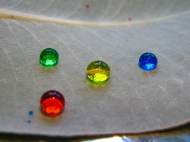Eucalyptus leaf wax coating could be used for self-cleaning surfaces
 Eucalyptus macocarpa, which is also known as The Rose of the West or Mottlecah, is a mallee Eucalyptus that is native to the south-west of Western Australia and noted for its large, spectacular flowers. Murdoch University researchers have discovered that it has unique self-cleaning and water-repellent properties which could be used in new nanotechnology applications.
Eucalyptus macocarpa, which is also known as The Rose of the West or Mottlecah, is a mallee Eucalyptus that is native to the south-west of Western Australia and noted for its large, spectacular flowers. Murdoch University researchers have discovered that it has unique self-cleaning and water-repellent properties which could be used in new nanotechnology applications.
The Mottlecah has silvery leaves covered in natural wax substance which causes water to form droplets that roll over the surface of the leaves and fall towards the root system of the plant, picking up any dirt along the way. These superhydrophobic and self-cleaning properties are similar to ones we already described on lotus plant properties which have already triggered development of self-cleaning and anti-bacterial technologies.
“I had noticed these incredible plants on the Murdoch campus because of the unusual appearance of their leaves”, said Dr Gerrard Eddy Jai Poinern, Senior Lecturer at the Murdoch’s School of Engineering and Energy. “They made me wonder whether the plant had superhydrophobic properties and so began our research investigation.
In their experiments, the researchers coated the leaf with carbon black toner from a laser printer cartridge and then observed how the rolling drops of water were able to completely clean the surface of the leaf. They believe that wax gave the leaves remarkable wetting and self-cleaning properties in order to enhance the plant’s survival in dry climate by channeling every drop of water to its roots.
Dr Poinern and his team at the Murdoch Applied Nanotechnology Research Group also extracted waxes from the leaves and found that they were capable of self-reassembly. When coated on laboratory glass slides, the wax formed features which mimicked the complex three-dimensional geometry of the nano-sized bumps and pillars found on the original leaf surface, making the slide superhydrophobic.
“It was fairly easy and inexpensive to extract the wax from the leaves and yet the wax still had these remarkable qualities”, said Dr Poinern. “When the tested glass slides were placed horizontally onto a water surface, the added buoyancy support of the wax meant that it was able to carry a greater load than the uncoated slides.”
The researchers are confident there are other native plants in Western Australia which have similar properties, and they are continuing the research to find out more about these properties and how they can be fully utilized.
The discovered properties of eucalyptus wax could be useful in applications such as lab-on-a-chip settings, where microfluidic devices are used in advanced medical research and disease testing, or ship hulls where it could prevent the build up of harmful microorganisms.









HOW DID THEY EXTRACT THE WAX? I JUST NEED IT FOR MY RESEARCH STUDY. THANKS!!!! GOD BLESS!!